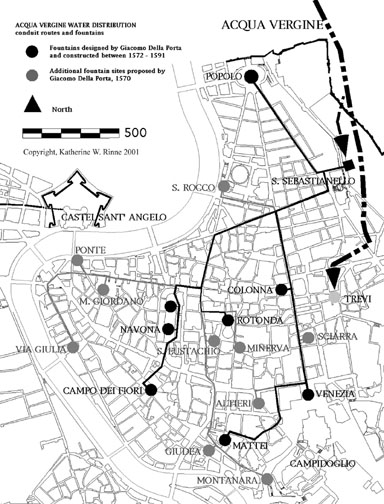
Katherine Rinne, "Fluid Precision: Giacomo della Porta and the Acqua Vergine fountains of Rome", in Landscapes of Memory and Experience, ed. Jan Birksted (London, 2000), 183-201.
This article investigates the role that topography and gravity-flow technology played in the development of a public fountain system for late cinquecento Rome. It specifically addresses those fountains designed by Giacomo della Porta between 1570 and 1591, all of which were located in the Campo Marzio, and utilized water from the newly restored Acqua Vergine. Della Porta's understanding of the relationship between topography and gravity evolved through the course of this work until it began to precede and influence design considerations such as where fountains were sited, their overall dimensions and formal structure, and how they displayed their waters. His work represents a real break with Medieval and Renaissance fountain traditions, which are exemplified by the public fountains of Florence, Siena, Naples, and Perugia. Della Porta translated this growing mastery of technical and topographical data into formal solutions that established a distinct identity for the fountains within the Vergine watershed, including those by other designers in the seventeenth and eighteenth centuries, such as Gian Lorenzo Bernini, Nicolo Salvi, Alessandro Specchi and Francesco da Volterra.
Acqua Vergine fountains designed by della Porta include those located in the piazza del Popolo, piazza della Rotondo (Pantheon), piazza Colonna, piazza Navona, piazza San Marco, Campo dei Fiori, and the "Tartarughe" (Turtle Fountain) in piazza Mattei. By looking to the specific topographies of each piazza, and its distance and elevation difference from the Acqua Vergine, these fountains are seen as site-specific designs that exploit the particular characteristics of water in a particular location. These fountains can then be understood to occupy an identifiable "watershed" and to be members of a family of fountains with identifiable characteristics.

Copyright, Katherine W. Rinne, 2000